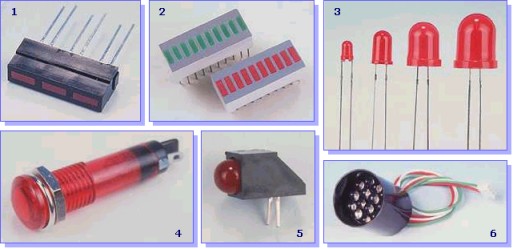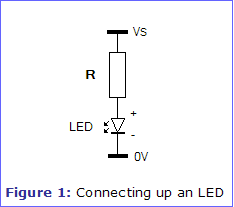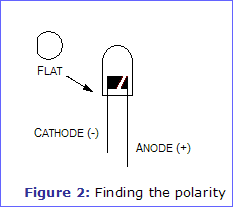
Light Emitting Diodes (LEDs)
By Tim Surtell
When you need to add light to a model, an ordinary filament lamp is the first thing that springs to mind. But if you don't need a high light output, or you need light as an indicator, an LED has many advantages over a lamp.
LEDs are available in many shapes and sizes, some of which are shown in the selection below. The 'standard' LED shape is the 5mm diameter domed type, and the smaller 3mm domed type is also popular.

1. Tri-LED array 2. 10 segment bar displays 3. Domed LED sizes 3, 5 ,8, 10mm
4. Panel mounting LED 5. PCB mounting LED 6. 26mm red & green LED cluster
LEDs have traditionally been red, orange, yellow, or green, but advances in LED technology mean that blue and white LEDs are now available, though at a much higher price. These LEDs are considerably brighter than standard LEDs so they could be used for lighting, but you will find the ones described as 'white' still have a blue tinge.
Also available are LEDs described as 'bi-color' and 'tri-colour'. Bi-colour LEDs typically incorporate one red and one green LED in the same package. Since they have only two leads, only one LED can be on at any time. Tri-colour LEDs also have two LEDs in one package, but because they have three leads, both LEDs can be switched on together, their light combining to make a third colour, typically orange. The central lead of such a package is the common for both LEDs.
Some manufacturers produce true 'tri-colour' LEDs incorporating red, green, and blue LEDs, so in theory it is possible to create light of any colour.
The physical colour of an LED package does not necessarily indicate the colour it will be when switched on. Some LEDs have a clear plastic package, while others may have a diffused plastic package.

1. Standard red, green and yellow LEDs 2. Bi-colour LEDs 3. Tri-colour LEDs
LEDs consume much less current than lamps - usually only 20mA - so they are ideal for battery powered models.
LEDs rarely fail (unless you supply them with the wrong voltage!) so are handy in parts of a model that are hard to reach.
|
|
 |
An LED is a diode, so current will flow in one direction through it, but not in the other direction. When an LED is 'forward biased' it will light and there will be a voltage drop of around 0.7V across it. When an LED is 'reverse biased', current will not flow through it and it will not light. It is this property that enables a bi-colour LED to have only two leads.
| Related Articles | Diodes |
Most LEDs require a forward bias voltage of around 2V and consume a current of around 20mA, but you should check the data available for the type of LED you are using to determine its exact voltage and current consumption.
To supply an LED with 2V at 20mA, you simply need to place a current-limiting resistor in series with it as shown in figure 1. The resistor value can be calculated using simple Ohm's law...
![]()
...where R is the resistor value in Ohms (Ω), and Vs is the voltage of your power supply in Volts (V). If you have different values for the forward bias voltage and current, then substitute them for the 2V and 0.02A values.

How can you tell which lead on an LED is which? Figure 2 shows a standard domed LED. If brought new, you will find that the longest lead is the positive lead, or 'anode', and the shortest lead is the negative lead, or 'cathode'. If the leads have been cut there are a few other ways to find out the polarity:
You can also connect up the LED (as in Figure 1) both ways around to see which is correct - reverse biasing the LED won't do it any harm.

Article Information
Source: Electronics in Meccano - www.eleinmec.com
| First published in EiM: Issue 2 (January 1999)
Topic: Components Explained |
Created: 22/12/2001 |
Last modified: 13/02/2007
Top of Page | Homepage | About | Search | Topics | Features | Circuits Shop | yourEiM |
© 1998 - 2025 Tim Surtell |